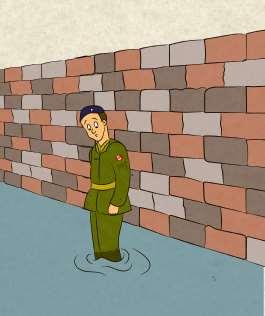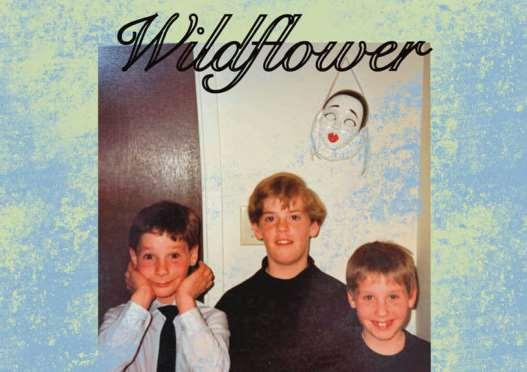
10 minute read
Comment pages 10 to
from 24 November 2021
COMMENT
I , B C . The wildfi re season in B.C. is considered the third worst on record, with , fi res burning , square kilometres of land. The only wildfi re seasons worse came just years earlier in and . B.C. residents could turn the corner of a valley on any given day to see the side of a mountain cascading with fi re. Many highways were closed to non-essential travel due to proximity danger.
Now, many of those same highways are gone due to the latest shift in extremes. On Nov. and , B.C. was hit with a massive deluge, drowning large portions of southern regions in the province. Communities were submerged by a dangerous mix of water and soil overnight. Lands were reclaimed by natural surroundings. Towns quickly started breaking rainfall records. Hope, B.C. reportedly quintupled its last record.
This rapid fl ux between drought and hellish fi re to rapid fl ooding is what . degrees of global warming looks like. Imagine what global thresholds will look like — if they are reached, that is.
The fl oods in B.C. are positioned to be the most expensive climate disaster in Canadian history. The cost of rebuilding highways, railways, towns and supply chains is estimated to reach several billions. B.C. Premier John Horgan declared a state of emergency and military assistance has been sent to help residents and start the clean-up process.
In a similar fashion to the wildfi res this summer, the military will be tasked with cleaning up the worst eff ects of the climate disaster. But this spectacle doesn’t sit right. Time and time again Canadians are made to rely on the military like it is Mr. Clean. But the fact is, when Prime Minister Justin Trudeau sends in the military to assist in climate crises, he is also hypocritically employing the largest emitter of greenhouse gases in Canada. It looks like Mr. Clean has mud on his boots.
By using the military for Canada’s climate crises, Trudeau is implying Canadians are on their own until after the damage is done. The prime minister clearly prefers to adapt to global warming rather than mitigate it. The military is part of the problem, not the solution.
According to a report completed by the Canadian government, the Department of National Defence (DND) contributes to over half of the government’s total emissions. It’s not only the gas-guzzling war machines that emit toxins into our air, either — the cyclical production of new military gear also consumes massive amounts of energy. The production cycle in the military is in constant fl ux with new models of weapons being bought and manufactured on a regular basis. The DND has an annual budget of . billion and they make sure to spend it.
Beyond just emitting greenhouse gases, the Canadian military has been linked to leaking toxins and leaving bullet pollution from shooting ranges, letting dangerous levels of lead leach into the surrounding environment and water systems. The government has also historically disposed of dangerous biohazardous material in environmental sites.
In a signatory letter addressed to Trudeau earlier this year, the Canadian Foreign Policy Institute requested Canada stop purchasing expensive, useless and environmentally damaging fi ghter jets. In the letter, the Institute noted the cost of buying a new F- stealth fi ghter jet — produced by the notorious weapons manufacturer Lockheed Martin — would set taxpayers back billion. However, the life cycle of a jet could cost closer to billion — money that should be used to reduce emissions and transition to a clean economy.
Despite the Canadian military’s horrifi c record during the largest climate crisis in human history, Canadians have been wholly uncritical of its infl uence. Discourse regularly surrounds multinational corporations, and rightfully so. However, the military machine that consistently pumps damaging chemicals and fumes into our air and water — while simultaneously eating into the tax revenue the government could use to mitigate climate change — cannot be overlooked.
sta ff
Perhaps it is because the military has consistently played the supposed heroic role in climate crises that it is uncritically left out of the general discussion about who is responsible for the destruction of the planet. News coverage on natural disasters consistently exploits images of military personnel holding victims in blankets or scaling a helicopter to reach people stranded on their rooftops. The truth is that these people are being saved by the very institution creating the conditions for their rescue. If the Canadian government stopped buying new military toys and focused on decarbonization, B.C. likely wouldn’t be in this environmentally volatile situation. Canada needs to do more than adapt to undesirable circumstances. To decarbonize, Canada must fi rst demilitarize.
ARTS & CULTURE
. / stars
T - C S - M W , . Originally drawing comparison to noisy art rock legends like Pavement and Sonic Youth, their new album Knows No Kindness brings infl uence from ’ s folk rock and alt-country, with widescreen expansiveness and a renewed focus on songwriting and storytelling.
The opener, “Tommy,” begins with a full minute of piano and vocals alone, a shockingly direct statement from a band that once stood behind walls of distortion and noise. This isn’t to say they’ve abandoned their post-punk and indie rock roots — “Tommy” eventually builds to a cathartic climax complete with duelling guitars and a belted chorus — but they’ve certainly expanded their range, and you can feel their confi dence in these songs. Band members Melanie St-Pierre and Neil Bednis were essentially co-frontpeople on Mercy Works, but here St-Pierre takes the lead. Her soaring vocals serve as a valuable counterpoint to the grungy instrumentals, as on “Witness,” a sludgy, queasy pounder of a song, lifted out of the murk by her clear, ethereal tone.
The band’s lyrics are occasionally ear-catching and quite interesting on the surface level, but don’t translate well to close readings. “Thesis,” for example, seems heavy in some way, but it’s unable to make sense of its empty folk signifi ers of open roads and Jesus on the cross. Not to say there isn’t genuine emotion here, but an album that takes itself so seriously, presented with a sepia photo of an environmental protest for a cover, feels like it should have more universal resonance.
There’s also the issue of momentum, which dissipates quite quickly as the middle stretch droops into low tempos, glum melodies and thick atmospherics. They’ve absorbed the emotional heaviness of ’ s folk rock and the hazy sonics of ’ s indie, but none of the respective genres’ humour or adventurous spirit.
Still, Casper Skulls are skilled melodicists and players. Even as the album descends into gloom, the toplines sparkle and each song has its own instrumental quirks, like the doomy synth bass on “Monument” or the spacious, deceptively bare closer, “Stay the Same,” which is elevated by sparkly, gliding guitar lines. Knows No Kindness fi nds Casper Skulls stuck between the gauzy indie rock of their past work and the straightforward singer-songwriter style they’re reaching toward, but it’s still a rewarding listen, full of promise.

ARTS & CULTURE
T “ ” J M M , O .
On a July morning that fateful year, the residents of Cathedraltown — a residential neighbourhood of Markham — awoke to fi nd a giant chrome cow on -foot tall stilts in the parkette that acts as a front lawn to some houses on Charity Crescent.
The public art piece, titled Charity, Perpetuation of Perfection, was donated by Helen Roman-Barber as a tribute to a decorated Holstein cow named Charity who was part-owned by her father — previous owner of the land Cathedraltown was developed on.
The stilts were integrated into the statue so that Charity could face the cathedral built by Roman-Barber’s father, Stephen Roman of Romandale Farms.
Most importantly, the neighbourhood had never been contacted about the placement or creation of the art piece.
Cue the irony of Charity as an act of charity. The interactive digital documentary Charity, created by Canadian artists Parastoo Anoushahpour, Faraz Anoushahpour and Ryan Ferko and funded by the National Film Board of Canada, analyzes the true story of the statue erected in the Markham residential neighbourhood.
Running approximately minutes in length depending on how much time is spent on the interactive features, the documentary walks viewers through the development of the statue, its placement and the neighbourhood’s fi ght against city council to remove it.
Charity is a unique experience that pushes the boundaries of how documentaries can be made and how artefacts can be presented to the audience.
This is particularly noticeable through the combination of audio of the neighbourhood council hearing to remove the statue with video of a real estate agent struggling to fi nd clients to purchase a house on Charity Crescent.
The awkward moments of this experimental documentary are in its technological format — the documentary is much more interactive when played on a smartphone, but the horizontal orientation of a computer consistently shows the artifacts in their entirety.
And though understandably important in order to show how many residents would regularly see the absurd statue, the amount of windows in the homes facing the statue is a repetitive theme throughout the documentary.
Regardless of the limited interactive aspects when viewed on a computer, Charity is defi nitively an accomplished digital documentary experiment.
The ludicrous situation of awaking to the sight of a giant cow statue is continuously and humorously expressed throughout the documentary, complete with archival footage from CTV highlighting a windstorm that turned a steel maple leaf from the wreath around the statue’s neck into the equivalent of a ninja star.
Where Charity most succeeds is in asking questions: who gets to make public art, who gets to donate public art and who gets a say in the development and implementation of public art?
As humorous as it is educational, Charity is a worthwhile gander into the sometimes-absurd world of donated public art.

Charity is currently live at n .ca/ interactive.
SECTION
. / stars
B I S , , W ’ . Among the three EPs released in the past year, its most cohesive is wild fl ower.
Meadows’ online presence is meagre and mysterious and its visual aesthetic loose and dreamy, with each release represented by rough handdrawn sketches or blurry old photos carrying a running colour scheme of sky blues and blank white. The music feels wistfully nostalgic and ethereally pretty but rough around the edges. The recordings are purposefully amateurish: microphone buzzes, out-of-tune vocals, digital distortion and all — but these imperfections put forward a striking vulnerability and sincerity.
Take the opener, “crows,” a song that plunges listeners right into wide-open bliss, with gentle acoustic guitars and synthesized strings swimming in an ocean of white noise and reverb. Schellenberg’s vocals, like those of the best lo-fi vocalists, have a perfect mix of catatonic chillness and open emotion, muttering simple truths and refl ective images in an elongated drawl. The mix is hazy and dreamy, but careful to never bury Schellenberg’s voice or the group’s instrumental melodies.
The next song, “turn,” is a quick, seriously catchy pop song, more immediate but still oddly cryptic and unsettling, its unsteady beat and cyclical chorus hobbling along like a malfunctioning merry-go-round. This uneasiness settles on “evelyn,” a truly gorgeous song surrounded by swirling synths and plaintive piano.
The momentum slows on “glow,” an incandescent ballad centred on a humming chord organ and a painfully exposed, aching vocal. The track falls into a mess of sampled conversation and noise, like being overwhelmed by churning sounds while having a public breakdown. This leads into the haunting instrumental “fl owers in the kitchen sink,” with its enveloping mix of watery synths and unconventional fi eld recordings. “Rosethorn” and “honey tea,” a pair of comforting indie pop tracks, are stark and bare arrangements, fi nishing the album on a grounded note.
Wild fl ower is nakedly emotional, ethereal and frequently achingly beautiful music. The album’s homespun aesthetic might take some getting used to, but for any fan of lo-fi music, this is release is not to be missed.







